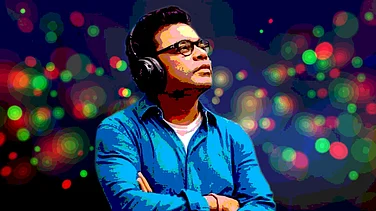“To gaze into the depths of the sea is, in the imagination, like beholding the vast unknown, and from its most terrible point of view. The submarine gulf is analogous to the realm of night and dreams. There also is sleep, unconsciousness, or at least apparent unconsciousness, of creation. There in the awful silence and darkness, the rude first forms of life, phantomlike, demoniacal, pursue their horrible instincts.”
Victor Hugo, The Toilers of the Sea
It is an illusion. Like the sea. The pink foot in the frame, shrunken and shrivelled, stretched and exaggerated with its many lesions and cracks can repulse, cause disorientation. Perhaps the artist intended it to be confrontational. The Trench Foot (immersion foot syndrome) causes damage to the circulation and nerve function of the foot. That’s the bane of the toilers of the sea. Of the sanitation workers. The sea can corrode, too. But who? And what? Limbs, spaces, etc.
This foot is a story, a record, an evidence and an ode to the ordinary body, to the powers of the sea. The larger-than-life acrylic on canvas painting by Parag Sonarghare is part of ‘Sea: A Boiling Vessel’ at Mattancherry in Kochi in an old house that serves as a holder of all stories of the sea and its people, their bereavements and their loss like the ability and the colour of the foot. For the artist, the work speaks of those who inhabit the ‘grey zone’, the space between life and death, the inhabitants of which are irretrievably lost. The hyper-realistic image took him one-and-a-half years to make. He says he had been looking for a subject when he encountered a man whose face he would have drawn if it hadn’t been for his foot that was scraped and cracked.
He wouldn’t reveal where because pain of the poor is also universal and not only particular. The water can erode. Skin, identities and landscapes.
“He could be a sanitation worker who goes deep into the pits or could be the sailor,” he says. “It is a reflection of a journey and it has to generate some experience. People said they were repulsed by it. It is a mirror.”
Sonarghare’s painting is a take on the slave narrative. It makes one think of an uncared body that may have accumulated negligence over time. It suggests a departure from the land to the sea and a prolonged exposure. The male figures in Sonarghare’s canvas are older men from lower socioeconomic strata. His images bear the marks of time—the wrinkles, wounds, rough edges and imperfections. That’s how the ordinary are. That’s his way of resisting the reign of what is standardised as “beauty” in the art world.
***
The three-month-long art event ‘Sea: A Boiling Vessel’ that opened on December 13 at the historic Hallegua House in the Jewish town of Mattancherry, which has surfaced in curator Riyas Komu’s works over the years, looks at the sea as a protagonist in the coastal state’s past, present and the future. The 13 artists whose works are displayed have used different mediums to explore narratives of origin and slavery, metaphorical immortality of the ocean and migration, among others. Organised by Aazhi Archives—an informal collective of artists, writers, scholars and academicians—‘Sea: A Boiling Vessel’ is running parallel to the Kochi-Muziris Biennale. “The title of the event was taken from the description of the Indian Ocean by a seafarer,” says Komu.

It is an unusual form of storytelling with different rooms in a house that once belonged to those that came via the sea to find refuge here. Called ‘Krathi Veedu’, it is a Dutch house in Jew Town belonged to Joseph and Juliette Hallegua for over a century. Built in 1761, it has now been converted into a museum by its owner Edgar Pinto. On the wall of the living room, photos of the Hallegua family’s last occupants of the house hang as part of the narrative of the sea that seeps into the town’s matrix of various identities. The 1,200 sq-ft mansion has tall windows that open out into the streets that have changed over the years with new narratives of nation-building taking over. But all erasures are mere illusions. The stories outlast all shifts. The exodus of Jews was gradual and Juliet Hallegua and her 40-something daughter Yael Hallegua chose to live here until they could not anymore, and they left in 2019 for Israel. The historic Jewish home has been a witness to the sea change that Mattancherry has gone through over the years. Like all coastal towns, it is faced with climate change, rising sea levels, extreme rainfall and intense tidal flooding.
This curation fixates time, it is a mosaic made of time, a reflection of the place that the sea shaped and continues to reconfigure and includes the arrivals and the departures and their impact.
Stories Of Seafarers
In a room, the walls have photos of men and women dressed as kings and queens in bright costumes and ornate jewellery of those who once ruled this place. The ethnographic work by KR Sunil called ‘Story Tellers of the Sea Shore’ explores the everyday life of the practitioners of Chavittunadakam, a music-dance-drama composition that goes back to the times of the Portuguese rule in South India. In these photos where men have heavy facial makeup and sport costumes that mimic that particular past, there is also the paradoxical element of their real lives, their identities that are tied to their backward Dalit and fishermen castes and their conversion to Christianity in the hope that there might be some redemption. In these photos, there is that audacity of the gaze of these men who dress as kings in the squalor of their surroundings that are threatened by climate change brought upon by global warming in coastal areas.

That juxtaposition with the past which is now an idea, a post-memory story, with the present, is what gives yet another dimension to the sea and the stories of the seafarers like those that Ibrahim whom Sunil met in 2017 told him.
Ibrahim grew up hearing stories of the sea from his father who was a deck-hand. He began his voyages at the age of 16 to the ports of India and Arabia.
Most of the sails originated from Kozhikode on motorised dhows and headed towards the ports of Kuwait, Sharjah, Muscat and Oman with cargos of wood planks, coir products, brahmi sherbet, pickles and so on. On the way back, they collected things like attar (perfume), dates, almonds, clothes to sell at home.
This enterprise brought in more money than their regular wages. Frozen in time and space and yet with some element of past continuum, the photos talk about identity, nostalgia and the inter-connectedness of cultures via the sea.
“Ibrahim condenses all his experiences into one phrase—‘Sea is an eternally boiling vessel,” says Sunil. “I had become thoroughly curious about the life and art of these economically backward people, whose life was a perennial battle against floods and high tide.”
What stands out in the images is the impoverished setup, their tiny huts and the ankle-deep, muddy, and filthy seawater in which they are standing. There is an alternative life they imagine. In this resurrection of the past, there is also a lament, almost a dirge. The room holds the gazes and the room in the old house becomes an echo chamber of the past intersecting with the present and everything imagined is also everything real.

The haunting portraits are windows into a vanished world from a world that’s disappearing too. They are then the bearers of nostalgia, the sea stories and the witnesses of the flux within the sea. Their gazes confronts the viewer with all their histories and their pain. The sea then is a reminder, according to Aazhi Archives “… of histories of migration, lineages of cross-pollination and synthesis of cultures, livelihoods and religions, settlements and segregations, and also of colonial plunder and slave trade that have effectively shaped the long sea coast of Kerala.”
In the house that is no more a house where an old woman called Juliette stares from a photo frame, the sea has been compressed into frames and sculptures. Outside, it touches the shores and recedes. In a loop. It is a tomb, a passage, a place that remains. A vessel that boils. A time capsule.
‘Sea: A Boiling Vessel’ will be on till April 30, 2023.


























